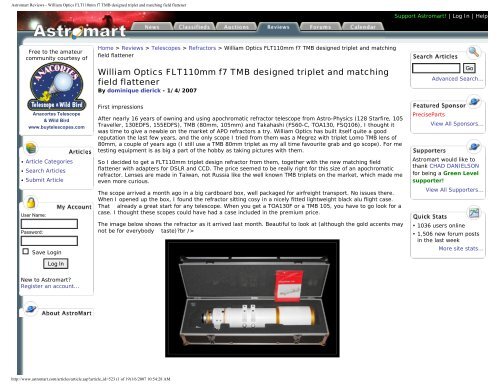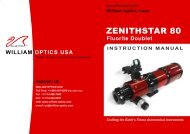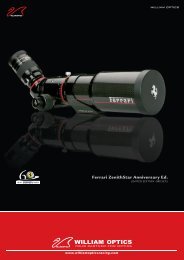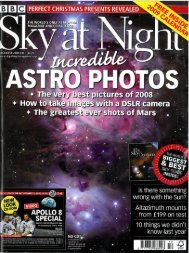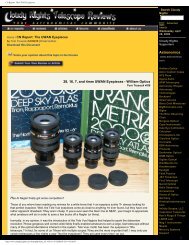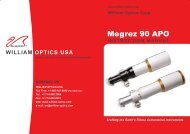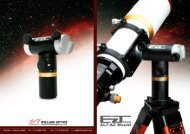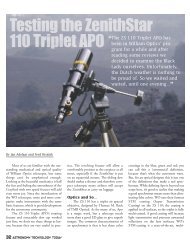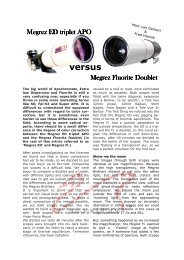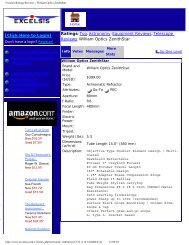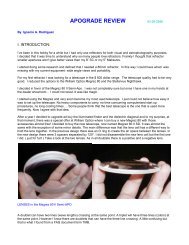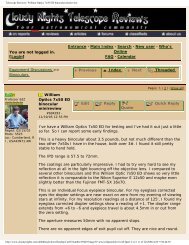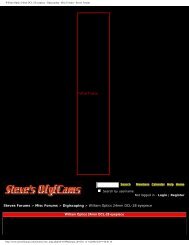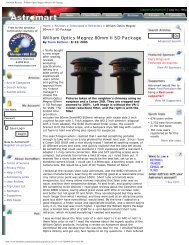Astromart Reviews - William Optics FLT110mm f7 TMB designed ...
Astromart Reviews - William Optics FLT110mm f7 TMB designed ...
Astromart Reviews - William Optics FLT110mm f7 TMB designed ...
Create successful ePaper yourself
Turn your PDF publications into a flip-book with our unique Google optimized e-Paper software.
<strong>Astromart</strong> <strong>Reviews</strong> - <strong>William</strong> <strong>Optics</strong> <strong>FLT110mm</strong> <strong>f7</strong> <strong>TMB</strong> <strong>designed</strong> triplet and matching field flattener<br />
Support <strong>Astromart</strong>! | Log In | Help<br />
Free to the amateur<br />
community courtesy of<br />
Home > <strong>Reviews</strong> > Telescopes > Refractors > <strong>William</strong> <strong>Optics</strong> <strong>FLT110mm</strong> <strong>f7</strong> <strong>TMB</strong> <strong>designed</strong> triplet and matching<br />
field flattener<br />
<strong>William</strong> <strong>Optics</strong> <strong>FLT110mm</strong> <strong>f7</strong> <strong>TMB</strong> <strong>designed</strong> triplet and matching<br />
field flattener<br />
By dominique dierick - 1/4/2007<br />
Advanced Search...<br />
Anacortes Telescope<br />
& Wild Bird<br />
www.buytelescopes.com<br />
• Article Categories<br />
• Search Articles<br />
• Submit Article<br />
User Name:<br />
Password:<br />
Save Login<br />
First impressions<br />
After nearly 16 years of owning and using apochromatic refractor telescope from Astro-Physics (128 Starfire, 105<br />
Traveller, 130EDFS, 155EDFS), <strong>TMB</strong> (80mm, 105mm) and Takahashi (FS60-C, TOA130, FSQ106), I thought it<br />
was time to give a newbie on the market of APO refractors a try. <strong>William</strong> <strong>Optics</strong> has built itself quite a good<br />
reputation the last few years, and the only scope I tried from them was a Megrez with triplet Lomo <strong>TMB</strong> lens of<br />
80mm, a couple of years ago (I still use a <strong>TMB</strong> 80mm triplet as my all time favourite grab and go scope). For me<br />
testing equipment is as big a part of the hobby as taking pictures with them.<br />
So I decided to get a <strong>FLT110mm</strong> triplet design refractor from them, together with the new matching field<br />
flattener with adapters for DSLR and CCD. The price seemed to be really right for this size of an apochromatic<br />
refractor. Lenses are made in Taiwan, not Russia like the well known <strong>TMB</strong> triplets on the market, which made me<br />
even more curious.<br />
The scope arrived a month ago in a big cardboard box, well packaged for airfreight transport. No issues there.<br />
When I opened up the box, I found the refractor sitting cosy in a nicely fitted lightweight black alu flight case.<br />
That already a great start for any telescope. When you get a TOA130F or a <strong>TMB</strong> 105, you have to go look for a<br />
case. I thought these scopes could have had a case included in the premium price.<br />
The image below shows the refractor as it arrived last month. Beautiful to look at (although the gold accents may<br />
not be for everybody taste)?br /><br />
PreciseParts<br />
View All Sponsors...<br />
<strong>Astromart</strong> would like to<br />
thank CHAD DANIELSON<br />
for being a Green Level<br />
supporter!<br />
View All Supporters...<br />
• 1036 users online<br />
• 1,506 new forum posts<br />
in the last week<br />
More site stats...<br />
New to <strong>Astromart</strong>?<br />
Register an account...<br />
http://www.astromart.com/articles/article.asp?article_id=523 (1 of 19)1/6/2007 10:54:28 AM
<strong>Astromart</strong> <strong>Reviews</strong> - <strong>William</strong> <strong>Optics</strong> <strong>FLT110mm</strong> <strong>f7</strong> <strong>TMB</strong> <strong>designed</strong> triplet and matching field flattener<br />
• Terms of Service<br />
• Privacy Policy<br />
• Help & FAQ<br />
• Astronomy Links<br />
• User Profiles<br />
• Top Users List<br />
• Sponsors<br />
• Supporters<br />
• RSS Feeds<br />
Who wins?<br />
Florida<br />
Ohio State<br />
View Comments (4)...<br />
Previous Polls...<br />
The finish of the optical tube is white pebble, giving the impression of long lasting durability and stability.<br />
Mechanics of the focuser are impressive and one gets the impression it is possible to tune it to the very last bit.<br />
The focuser has two rotating mechanisms, one for the complete focuser, and one at the end of the drawtube for<br />
an extra camera rotation. Perhaps a bit of overkill, but still, if you want to rotate the camera independent from<br />
the focuser knobs, it will be possible.<br />
A little warning should be made here. Loosening the focuser rotation mechanism setscrew too much will cause the<br />
entire assembly to tilt suddenly in the rotation holder. I haven• tried to unlock the setscrew completely and see<br />
whether there is a risk of dropping the entire focuser, but ok, if you know that care is needed, I don• see a major<br />
issue here. Unlock the setscrew just enough so you can rotate the focuser. If you use heavy accessories you may<br />
want to screw in the plastic setscrews a bit with a flat screwdriver as WO suggested to me. By default it ships<br />
quite loose. This does help in fixing the issue, but it not the same quality feeling as the Takahashi TOA rotator<br />
or the 3.5?Feathertouch focuser rotation mechanism though. So, rotate first, fine focus then is the message here.<br />
Anyway this is a policy I am using with all rotation mechanisms on focusers.<br />
The focusing mechanism itself is buttery smooth and stable for visual and DSLR use. I could not detect imaging<br />
shift while focusing. The dual speed mechanism is a blessing for every telescope and in this case very well done.<br />
It certainly feels more like the well known Feathertouch quality than the one of the Takahashi TOA dual speed<br />
knob (which I think could be made better). The focuser locking screw does what it has to do: lock the focuser in<br />
place when needed.<br />
But again a little warning?by default the tension on the focuser is NOT sufficient for an SBIG STL camera. You<br />
need to lock the hex screw underneath the focuser to avoid a potential heart attack when you see your SBIG<br />
slipping ?fast! Fortunately there is an internal mechanism of the focuser which prevents the drawtube from falling<br />
out, but you don• want to take any risk with your expensive camera. It is a bit difficult to find the right balance<br />
point between adding friction for a heavy STL camera and still keeping smoothness with the 10-1 reduction. Too<br />
much friction and the focusing knob will start slipping; too little friction and your camera will slip. When the hex<br />
screw is tightened for the STL, the standard locking thumbscrew became quite useless, it does not lock anything<br />
anymore and I was relying on the hex screw friction alone. <strong>William</strong> <strong>Optics</strong> suggested replacing the thumbscrew<br />
with a longer one so that it locks better under heavy weight. They also mentioned using not only the large hex<br />
screw to put additional friction, but also the two other (smaller) ones, again with the drawtube fully racked out<br />
when performing this operation! Basically when doing all this, one should find a good combination. At least it<br />
works for my STL. On the image below you can see the camera sitting cozy held by friction on a vertically placed<br />
tube. Focusing is still possible. I can• show this so you will need to believe me on that one.<br />
http://www.astromart.com/articles/article.asp?article_id=523 (2 of 19)1/6/2007 10:54:28 AM
<strong>Astromart</strong> <strong>Reviews</strong> - <strong>William</strong> <strong>Optics</strong> <strong>FLT110mm</strong> <strong>f7</strong> <strong>TMB</strong> <strong>designed</strong> triplet and matching field flattener<br />
http://www.astromart.com/articles/article.asp?article_id=523 (3 of 19)1/6/2007 10:54:28 AM<br />
The drawtube itself is engraved with a scale. Handy to more or less raw focus cameras after you have determined<br />
the needed distance once. It will not be good enough for repetitive CCD or DSLR work, but you have a starting<br />
point for fine focus very fast. I remember that with my AP focusers, I marked the drawtube with a thin hairline<br />
using a razorblade. No need to get the razor out with this focuser.<br />
The 2?adapter only has one setscrew. I don• like that kind of system, especially since the 2?WO adapter is a bit<br />
on the wide side and definitely not the best part of the focuser. My Herschel wedge for solar observations did not<br />
sit very comfortable in the focuser, was difficult to lock in place and hard to keep it square. I do have a Baader<br />
multifunction 2?adapter which happened to fit the 4 inch <strong>William</strong> <strong>Optics</strong> focuser, so I replaced the original 2?<br />
adapter with the Baader one (which is more robust and has two setscrews to lock accessories) to get a much<br />
better fit. You can see the Baader adapter on the STL setup picture. OK, I am being picky on these things. A<br />
scope may be optically excellent, but if you cannot mount accessories square, you reduce the potential. It doesn•<br />
cost an arm and a leg to make a good adapter like the clamp ring style of the 3.5 inch Feathertouch or the 3<br />
setscrews of an Astro-Physics focuser.<br />
There is one thing I regret with the WO 4 inch focuser. It has the same end threads as the Takahashi focusers,<br />
but female, whereas the Takahashi has male threads. Too bad, as it would have opened the door for use of all<br />
Takahashi accessories like their fabulous reducer-correctors! Anyway, I had an adapter made locally by Eric<br />
Moerman to convert to Takahashi threads, so I can use their 2.7?reducer-corrector for photographic testing of the<br />
FLT110. It should be easy for <strong>William</strong> <strong>Optics</strong> to add such an adapter to their product line. As a matter of fact,<br />
standardizing connections in telescope land would be a great thing in general for consumers?br /><br />
Perhaps this all sounds a bit negative on the focuser. For many purposes it will be excellent, but one should know<br />
it does have its little shortcomings which you may need to look after with heavy accessories. A few of these<br />
shortcomings could have been factory solved easily.<br />
The tube itself is well baffled and dark inside for high contrast. Looking from the back through the telescope, I do<br />
not have the impression any of the baffles would vignette the light cone, although the first baffle on the front end<br />
is pretty close.
<strong>Astromart</strong> <strong>Reviews</strong> - <strong>William</strong> <strong>Optics</strong> <strong>FLT110mm</strong> <strong>f7</strong> <strong>TMB</strong> <strong>designed</strong> triplet and matching field flattener<br />
By now it is time to mount the telescope on a mount. The image below shows the FLT110 on my AP600 GTO<br />
mount, with the dedicated field flattener and DSLR adapter in place.<br />
The FLT110 is light enough a telescope (6 to 7 kgs depending on accessories) to not require a heavy equatorial<br />
mount. It will fit easily on a Vixen Sphinx or GP-DX mount, or on Losmandy GM8 equatorial system. So<br />
portability will hardly be an issue, not even for people who need to drive to an observing site.<br />
Visual observations, in depth comparisons<br />
Even though I am a photographer more than a visual observer, I decided to first have a good visual observation<br />
run with the telescope before star testing it. This avoids getting biased upfront. The telescope certainly does not<br />
disappoint visually.<br />
Compared with <strong>TMB</strong> 80mm and Takahashi TOA130F<br />
I observed some deep sky objects with Nagler eyepieces and the stars to me are sharp as needle points. My<br />
TOA130 still does a better job in rendering the stars perfect, but this scope is not in the same price league! The<br />
moon is quite spectacular in the 110mm telescope and views are gorgeous with plenty of contrast and resolution.<br />
Saturn pulled up a nice show, even at 277x (5mm <strong>TMB</strong> eyepiece and 1.8x <strong>TMB</strong> ED Barlow lens) it was still very<br />
good. Higher magnifications could be possible, but some slight image softness started to become noticeable at<br />
277x, so I did not push it beyond that limit that night.<br />
I compared the FLT110 with my 1/10th wave <strong>TMB</strong> 80mm (made in Russia) and found the in and out focus images<br />
of the 80mm to be in a somewhat higher league than the FLT110. While the in and out focus images of the little<br />
<strong>TMB</strong> are virtually textbook perfect, much like the TOA130F I have (which again is a bit better than the <strong>TMB</strong> - how<br />
perfect perfect can be I wonder), I do see slight residual spherical aberration left in the FLT110 telescope and a<br />
tiny bit of a zone. Not much, but it is not a perfect star tester. The patterns are not as well defined as with the<br />
80mm <strong>TMB</strong> or the TOA130.<br />
http://www.astromart.com/articles/article.asp?article_id=523 (4 of 19)1/6/2007 10:54:28 AM
<strong>Astromart</strong> <strong>Reviews</strong> - <strong>William</strong> <strong>Optics</strong> <strong>FLT110mm</strong> <strong>f7</strong> <strong>TMB</strong> <strong>designed</strong> triplet and matching field flattener<br />
Now, how serious is this slight residual spherical aberration and little zone? Not that serious I would be worried<br />
about it. It will take superb seeing conditions, excellent eyepieces and a keen visual eye to detect real differences<br />
on a planet I thought that night. Unfortunately <strong>William</strong> <strong>Optics</strong> does not give absolute quality numbers for these<br />
refractors, so it is difficult to judge if the one I received is representative. If judged by the simple criterion etter<br />
than diffraction limited? it most certainly passes the visual test.<br />
For curiosity sake, on another night I pushed the magnification on a distant spider web (illuminated by a<br />
streetlight) to 385x and the image remained sharp. I perform this spider test with all my telescopes, and the WO<br />
obviously did very well. Comparison with the TOA130 on the same spider web target definitely gave a resolution<br />
and brightness edge to the TOA (with 2 cm more aperture) which was to be expected. The image and contrast<br />
quality was very close, with the TOA still giving an advantage in sharpness and contrast (which does not surprise<br />
me as the Takahashi TOA is a superb piece of optic).<br />
The image below shows the test setup with the FLT110 and <strong>TMB</strong> 80 on my AP1200 GTO mount. Please note there<br />
is a blue sky each time I take an image of the equipment. Usually this blue sky disappears as soon as I want to<br />
do observing with the instruments.<br />
Compared with <strong>TMB</strong> 105mm<br />
We (Philippe Vercoutter, Jorg Versluys and myself) also compared the <strong>TMB</strong> 105mm f6 with the FLT110 under the<br />
dark skies of Grandpre, France. Given the star test reveals even tiny imperfections, we started with that test this<br />
time.<br />
We tried to evaluate the in and out focus patterns as good as seeing would allow us and the results were very<br />
good visually, but not as symmetrical as the patterns in the <strong>TMB</strong> 105. We also tried recording the impressions on<br />
video. Ideally, such video tests should be done in-house in lab conditions we soon realized. Seeing was not really<br />
good enough to allow the desired highly magnified star patterns on video and still keep enough resolution in the<br />
resulting image stack. But ok, the low magnification test does give an idea on what to expect. The human eye<br />
still has an edge on adaptive optics it seems ;) Perhaps I will try to do the test with video later on to show a<br />
higher magnified version. Given the fact it is cloudy most of the time, that could be in a very distant future<br />
though!<br />
The left side of the image below shows the infocus pattern, the right side the outfocus pattern, while the middle is<br />
a star in focus with the first diffraction ring visible. The outfocus image as usual suffers more from seeing<br />
turbulence.<br />
http://www.astromart.com/articles/article.asp?article_id=523 (5 of 19)1/6/2007 10:54:28 AM
<strong>Astromart</strong> <strong>Reviews</strong> - <strong>William</strong> <strong>Optics</strong> <strong>FLT110mm</strong> <strong>f7</strong> <strong>TMB</strong> <strong>designed</strong> triplet and matching field flattener<br />
One can see a few •icks?in the outer ring of the pattern. This may have been caused by the producer clamping<br />
the lens on 3 points during production, or even from lens cell effects. Given the effect is so minor and does not<br />
really give the impression of pinched optics, I did not bother to dig deeper into possible causes. For the<br />
perfectionists amongst us, this may lead (being careful here) to bumps or tiny spikes in the halo around stars<br />
when using image histogram stretching with DDP processing on long exposure images. But if you would use a<br />
DSLR or one of the blooming CCD most likely they will give more artefacts around stars on their own already.<br />
All images are the result of a stack of a few AVI movies in prime focus of the FLT110, made with a DMK 21AF04<br />
firewire camera.<br />
For the visual observations, we used similar eyepieces from <strong>TMB</strong>, and both equipped with a 1.8x <strong>TMB</strong> ED Barlow<br />
to obtain higher magnifications. The three of us had a very hard time to detect differences between the Orion<br />
Nebula trapezium stars and immediate vicinity.<br />
Both scopes show clean sharp stars with nice hints of real colour. One observer noticed a slight contrast<br />
advantage for the <strong>TMB</strong> 105, but not by all that much. I did not detect significant contrast differences on the<br />
nebula, nor any difference in the sharpness and clarity of the Trapezium stars.<br />
Saturn under good seeing was very nice in both scopes, with no differences to be noticed on the Cassini division,<br />
nor in the belts on the planet. We knew about the slight optical imperfections upfront, so we really looked very<br />
carefully to spot effects from it, but without success. Saturn was slightly brighter in the FLT110, showing 0.5cm<br />
more aperture. I did have the impression the equatorial belt on Saturn may have been slightly darker and give<br />
the idea of a bit more contrast in the <strong>TMB</strong> 105, but I wouldn• place a bet on it, as it can be related to the slightly<br />
brighter overall image. Both telescopes showed the subtle colour hues on Saturn.<br />
All this really makes evident how critical a star test can be. Everything shows, even marks that have in practice<br />
little influence on the end image.<br />
The clever design of the <strong>TMB</strong> 105mm dew shield (seen on the picture with Jorg) did prove its use in the field.<br />
Thanks to the tiny front baffle in the dew shield, the <strong>TMB</strong> 105mm remained dew free during the night with lots of<br />
moisture in the air. The FLT110 has no such front baffle and needed a Kendrick dew heater after a few hours.<br />
Jorg Versluys is seen carrying both the <strong>TMB</strong> 105mm and the WO FLT110. Notice the heavier looks of the <strong>TMB</strong><br />
105, but it is not really that much heavier than the FLT110.<br />
http://www.astromart.com/articles/article.asp?article_id=523 (6 of 19)1/6/2007 10:54:28 AM
<strong>Astromart</strong> <strong>Reviews</strong> - <strong>William</strong> <strong>Optics</strong> <strong>FLT110mm</strong> <strong>f7</strong> <strong>TMB</strong> <strong>designed</strong> triplet and matching field flattener<br />
While I was doing the star tests, another thing to look for was the centring of the lens. Since the lens cell cannot<br />
be collimated (there are no push-pull screws, just like on the smaller <strong>TMB</strong> 80 or AP Traveller), there is no room<br />
for error here. <strong>William</strong> <strong>Optics</strong> did a good job here: the lens is well centre collimated (as can be seen on the star in<br />
focus on the star test image too).<br />
Colour correction of the FLT110 is excellent. I could not detect false colour on the moon or bright stars.<br />
Defocusing the telescope did pop up ever so slight colour at the lunar limb when seeing degraded the image<br />
temporarily, but since the moon was only 40 degrees up in the sky it could very well have been diffraction colour.<br />
Nothing to worry about in practice again, as nobody looks at an image out of focus anyway.<br />
Compared to the 80mm <strong>TMB</strong>, the moon colour in the FLT110 was a tad warmer in tint. It reminds me of the tint<br />
of the moon in the Astro-Physics 130EDFS and Traveller I once used. The coating of the lens itself, when<br />
inspected with a flashlight, looks good. I have no means to measure transmission etc., but it did not show visible<br />
defects to me.<br />
Perhaps the best way to categorize overall visual optical performance of the FLT110 is to look at a lunar image I<br />
made. It is constituted out of 8 AVI movies with a DMK 41AF02 megapixel firewire camera for the luminosity part.<br />
I combined it with a few images made with Canon 20D for colour. A Takahashi Extender Q 1.6x Barlow system<br />
was used to magnify the image.<br />
For a full resolution and size image, see on my website at:<br />
http://www.astronomie.be/dodi/moon20061129.jpg<br />
The image below is a reduced crop of this image to show resolution and sharpness with the high resolution DMK<br />
camera on an evening of mediocre seeing conditions (unfortunately late fall is not the best season for stable<br />
seeing over here)<br />
http://www.astromart.com/articles/article.asp?article_id=523 (7 of 19)1/6/2007 10:54:28 AM
<strong>Astromart</strong> <strong>Reviews</strong> - <strong>William</strong> <strong>Optics</strong> <strong>FLT110mm</strong> <strong>f7</strong> <strong>TMB</strong> <strong>designed</strong> triplet and matching field flattener<br />
Photographic performance<br />
http://www.astromart.com/articles/article.asp?article_id=523 (8 of 19)1/6/2007 10:54:28 AM<br />
As mentioned, I am much more into astrophotography than into visual observing, so for me the big question<br />
always is: how does the telescope behave with a CCD mounted ;). Weather so far was not good enough to be<br />
able to do real deep imaging with the telescope, but I will try to update the review as soon as I get those kind of<br />
images.<br />
With the FLT110, I got the brand new <strong>TMB</strong> <strong>designed</strong> matching 68mm field flattener. This one comes with two<br />
adapters, one for DSLR (T2 thread) and one ring that ends in SC thread. The latter is a relatively thin ring, so it<br />
does not by itself provide the right spacing needed for best quality results! One should use a 2 inch nose piece<br />
with it and try to aim at the same metal back distance as the DSLR adapter, or replace it with a dedicated<br />
adapter for large format sensors. <strong>William</strong> <strong>Optics</strong> told me they will be making an adapter dedicated for the<br />
STL11000.<br />
The DSLR adapter will not introduce vignetting with a 1.5x APS sensor size, but at full frame it vignettes for sure.
<strong>Astromart</strong> <strong>Reviews</strong> - <strong>William</strong> <strong>Optics</strong> <strong>FLT110mm</strong> <strong>f7</strong> <strong>TMB</strong> <strong>designed</strong> triplet and matching field flattener<br />
Have a look at the below image comparing the hole sizes of STL (left), a dedicated STL adapter (middle) and the<br />
DSLR adapter of <strong>William</strong> <strong>Optics</strong>?br /><br />
I think <strong>William</strong> <strong>Optics</strong> should still make a better DSLR adapter, aiming at the EOS 5D and similar cameras. Quite<br />
a few mm can be won back by using a wide T mount system like the well known Takahashi or Astro-Physics<br />
wide rings. The standard T2 screw threads on the current DSLR adapter will do fine for smaller sensors, but leave<br />
full frame DSLR users with unnecessary light fall off (agreed, with current T2 adapter style for full frame DSLR<br />
even a wide ring will introduce some problems, but definitely less).<br />
Now, using a Canon 20D and STL4020 CCD myself, I don• have any of the mentioned problems of full frame,<br />
testimony this daylight sky image made with the FLT110, field flattener and 20D.<br />
http://www.astromart.com/articles/article.asp?article_id=523 (9 of 19)1/6/2007 10:54:28 AM
<strong>Astromart</strong> <strong>Reviews</strong> - <strong>William</strong> <strong>Optics</strong> <strong>FLT110mm</strong> <strong>f7</strong> <strong>TMB</strong> <strong>designed</strong> triplet and matching field flattener<br />
The only noticeable vignetting in this histogram stretched image is from the EOS reflex mirror itself. Till recently,<br />
I also had a Takashashi FSQ106n for photography, which really was a pain to use from my severely light polluted<br />
location. Razor-sharp, but the bright centre •otspot?in the FSQ was strongly pronounced by light pollution,<br />
making processing a difficult task and precise flatfields absolutely mandatory. No such thing here (nor in my<br />
80mm <strong>TMB</strong> or TOA telescopes fwiw).<br />
Next step in testing is of course the image quality. For this I aimed the telescope towards a distant tower of<br />
Ghent University. The tower is about 2km away from my apartment and imaging over this distance does cause<br />
some seeing turbulences. With this in mind, I made a few images at 100 ISO taking care to use mirror lockup to<br />
avoid vibrations and using a remote control in order not to introduce fuzziness above seeing influences. The result<br />
is excellent. At least with APS size sensor the image is virtually perfect to the very edges as you can see on the<br />
image with an inset of one of the corners.<br />
http://www.astromart.com/articles/article.asp?article_id=523 (10 of 19)1/6/2007 10:54:28 AM
<strong>Astromart</strong> <strong>Reviews</strong> - <strong>William</strong> <strong>Optics</strong> <strong>FLT110mm</strong> <strong>f7</strong> <strong>TMB</strong> <strong>designed</strong> triplet and matching field flattener<br />
And this is the corner itself at 100% size straight out of the camera....<br />
The excellent performance of the <strong>William</strong> <strong>Optics</strong> field flattener itself is also obvious on tests performed at night. I<br />
have analysed a few images made with my Canon 20D with CCD Inspector 1.2. The 3D surface below shows the<br />
good quality of the optical combination.<br />
http://www.astromart.com/articles/article.asp?article_id=523 (11 of 19)1/6/2007 10:54:28 AM
<strong>Astromart</strong> <strong>Reviews</strong> - <strong>William</strong> <strong>Optics</strong> <strong>FLT110mm</strong> <strong>f7</strong> <strong>TMB</strong> <strong>designed</strong> triplet and matching field flattener<br />
With a bit more care in picking the right spot to focus in the field of view, I suspect even better results will be<br />
possible.<br />
Below is a sample test shot of M42 (from my city balcony location), 30 second exposure, no extra guiding and<br />
made with the FLT110, Canon 20D mounted on my AP1200 mount.<br />
http://www.astromart.com/articles/article.asp?article_id=523 (12 of 19)1/6/2007 10:54:28 AM
<strong>Astromart</strong> <strong>Reviews</strong> - <strong>William</strong> <strong>Optics</strong> <strong>FLT110mm</strong> <strong>f7</strong> <strong>TMB</strong> <strong>designed</strong> triplet and matching field flattener<br />
I also tried the FLT110 with a Canon 5D full frame camera. As expected the narrow T2 adapter introduces corner<br />
vignetting, which will be less with a wider T2 adapter, and most likely not visible with a custom made STL adapter<br />
when using an STL11000.<br />
The image below shows the vignetting of the adapter with an EOS 5D after blurring to get rid of most of the stars<br />
except bright Regulus in the centre.<br />
http://www.astromart.com/articles/article.asp?article_id=523 (13 of 19)1/6/2007 10:54:28 AM
<strong>Astromart</strong> <strong>Reviews</strong> - <strong>William</strong> <strong>Optics</strong> <strong>FLT110mm</strong> <strong>f7</strong> <strong>TMB</strong> <strong>designed</strong> triplet and matching field flattener<br />
The most important fact however is that the <strong>William</strong> <strong>Optics</strong> <strong>TMB</strong> field flattener is sharp to the very corner of an<br />
EOS 5D full frame camera on the FLT110, no modest feat for any telescope to achieve and excellent news for<br />
those amateurs wanting to image with e.g. a modified 5D and the FLT110. I have not tried to make images with a<br />
dedicated CCD imaging camera so far, but I think the 5D images do reveal the possibilities of the combination.<br />
Below is the CCD inspector curve of 5 images, focused in the centre of the field of view resulting in 19.4% field<br />
curvature. By carefully focusing somewhere between the edge and the centre of the view an even better overall<br />
flatness number can likely be achieved. So one has to consider the image of the field curvature as the orst case?<br />
scenario. Also, CCD inspector is not perfect and is best subject to an average of many sessions to get real figures,<br />
which I didn• do here.<br />
http://www.astromart.com/articles/article.asp?article_id=523 (14 of 19)1/6/2007 10:54:28 AM
<strong>Astromart</strong> <strong>Reviews</strong> - <strong>William</strong> <strong>Optics</strong> <strong>FLT110mm</strong> <strong>f7</strong> <strong>TMB</strong> <strong>designed</strong> triplet and matching field flattener<br />
How it translates to a real life situation is seen on this corner image, histogram stretched, and exposed through<br />
the standard DSLR adapter and an EOS 5D at full resolution at 1600 ISO (unguided, 30s). Nicely sharp stars to<br />
the edges can be seen with no coma visible. Vignetting has not been corrected.<br />
http://www.astromart.com/articles/article.asp?article_id=523 (15 of 19)1/6/2007 10:54:28 AM
<strong>Astromart</strong> <strong>Reviews</strong> - <strong>William</strong> <strong>Optics</strong> <strong>FLT110mm</strong> <strong>f7</strong> <strong>TMB</strong> <strong>designed</strong> triplet and matching field flattener<br />
The same test on the <strong>TMB</strong> 105mm refractor with <strong>TMB</strong> field flattener gave a value of around 16% curvature, but<br />
the curvature cone was not centred on the optical axis, giving a slight asymmetric result over the 35mm format.<br />
As mentioned, with an adapter ring made by a friend of mine, I could also test the Takahashi TOA/TSA 2.7?<br />
reducer-corrector to work at approximately f 5.3. On the image below you can see how the TOA reducer is<br />
adapted to the <strong>William</strong> <strong>Optics</strong> focuser:<br />
http://www.astromart.com/articles/article.asp?article_id=523 (16 of 19)1/6/2007 10:54:28 AM
<strong>Astromart</strong> <strong>Reviews</strong> - <strong>William</strong> <strong>Optics</strong> <strong>FLT110mm</strong> <strong>f7</strong> <strong>TMB</strong> <strong>designed</strong> triplet and matching field flattener<br />
Weather was not cooperative to perform a test outdoors, but indoors I made the following image (not cropped)<br />
with a Canon 20D at ISO 800:<br />
http://www.astromart.com/articles/article.asp?article_id=523 (17 of 19)1/6/2007 10:54:28 AM
<strong>Astromart</strong> <strong>Reviews</strong> - <strong>William</strong> <strong>Optics</strong> <strong>FLT110mm</strong> <strong>f7</strong> <strong>TMB</strong> <strong>designed</strong> triplet and matching field flattener<br />
This is the small print on the box:<br />
Not bad for a reducer! In fact the image is sharp without any camera of software sharpening in Photoshop, down<br />
to the corners. I predict very good results on the stars (unless you start drinking too many of the above test<br />
subjects of course!).<br />
Conclusions<br />
http://www.astromart.com/articles/article.asp?article_id=523 (18 of 19)1/6/2007 10:54:28 AM<br />
So, who will benefit from the FLT110 telescope? Certainly most amateurs who are in the market for a relatively<br />
budget friendly APO refractor of moderate size.
<strong>Astromart</strong> <strong>Reviews</strong> - <strong>William</strong> <strong>Optics</strong> <strong>FLT110mm</strong> <strong>f7</strong> <strong>TMB</strong> <strong>designed</strong> triplet and matching field flattener<br />
I would say that the FLT110, optically and mechanically gives excellent overall quality and value for money,<br />
except for the slight star test imperfections and perhaps here and there some things could be made better on the<br />
focuser. Usually however you are not star testing a telescope, rather observing with it, and under these<br />
conditions these star test imperfections are not really significant as far as I (and others) could judge on multiple<br />
occasions. Excellent seeing conditions might reveal them to the experienced eye, but at least where I live, that is<br />
very rare.<br />
For deep-sky photography where ?by the nature of things ?you are working at an image scale which make it next<br />
to impossible to detect slight optical imperfections and where a sharp, apochromatic and flat image is the<br />
important criterion, from what we have seen above, most likely you can• go wrong with this telescope and its<br />
field flattener. But as mentioned, even for higher resolution lunar or solar imaging you will need superb seeing, a<br />
small pixel size camera and a perfect high quality Barlow to start to detect the difference with an optically perfect<br />
telescope.<br />
One important thing when buying a new telescope is the support you get after you bought it. In that sense I<br />
experienced <strong>William</strong> <strong>Optics</strong> as really helpful and responsive whenever a small issue popped up. Good to know.<br />
If on the other hand you only settle for the best in class beyond anything, and are willing/able to pay for it, you<br />
may want to move to another brand refractor. My Takahashi TOA130, Lomo <strong>TMB</strong> 80mm and the tested LZOS <strong>TMB</strong><br />
105mm are in terms of optical quality the better scopes, but not by all that much. I guess in that sense <strong>William</strong><br />
<strong>Optics</strong> has succeeded in offering a good apo with decent optics at a competitive price. Direct competition I see for<br />
the FLT110 are the vendors of Russian made <strong>TMB</strong> lenses (105 and 115mm) and the Takahashi TSA102 (be it at a<br />
smaller diameter and slower focal ratio). Not to mention even cheaper WO lones?hitting the market just<br />
recently. But not much is known about those yet.<br />
Now if <strong>William</strong> <strong>Optics</strong> would provide a wider T ring for an EOS 5D, and an STL adapter for the STL11000...<br />
bookmark it! | digg it! | reddit!<br />
News | Classifieds | Auctions | Forums | My Account | Help | RSS<br />
All times are in (GMT-8:00) Pacific Standard Time Zone<br />
http://www.astromart.com/articles/article.asp?article_id=523 (19 of 19)1/6/2007 10:54:28 AM


